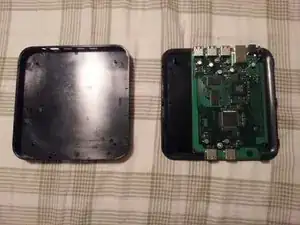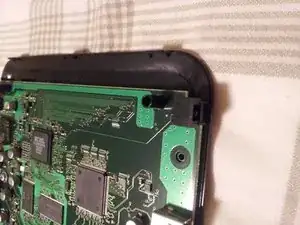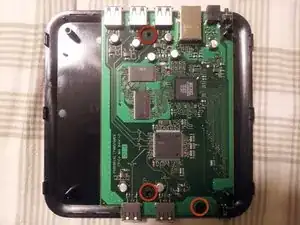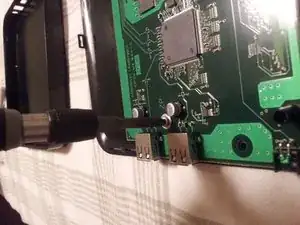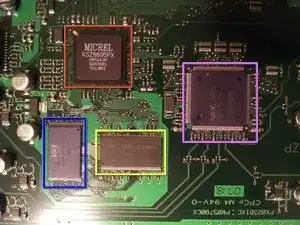Einleitung
This guide will step you through the disassembly of the Belkin F5L009 Network USB 5-Port Hub, which was once upon a time advertised as a network print server for USB printers, among other things.
I mostly did this teardown to evaluate the feasibility of adapting this device for use with operating systems other than Windows and Mac OS X (specifically, Linux-based operating systems).
Werkzeuge
-
-
Pictured here is the Belkin F5L009, along with a plastic opening tool and a #1 Philips (at least so the head says...), which were the only tools I needed to do this. A guitar pick or other thin, flat, plastic object might work instead of an opening tool; I didn't test it.
-
-
-
I began by flipping the F5L009 upside down.
-
The case is held together by small tabs all along the sides. Work the spudger between where the two halves meet. I started on the side with the ethernet port, since it seemed to be the most flexible.
-
Once you get a bit of the top and bottom halves separated on one side, start sliding the opening tool around the entire case until all the tabs are disengaged. I found them to be rather "soft" and easy to disengage without breaking them.
-
-
-
Carefully flip the device back onto its belly and lift the top off the bottom.
-
When I performed this teardown, I encountered a tiny piece of plastic over the indicator LED that fell off upon my removal of the top of the case.
-
-
-
Strangely, though there are three holes available for screws, I found only two screws actually holding the mainboard to the bottom half of the case. Unscrewing them both was all it took to get the mainboard free.
-
Underneath the two screwholes down the middle of the device are tiny plastic spacers. Don't lose those.
-
-
-
The mainboard has four big integrated circuits worth mentioning. Three of their datasheets are attached to this guide for reference.
-
The Micrel "Centaur" KSZ8695PX in the upper-left is an ARM-based system-on-chip. Specifically, it features a single 166MHz 32-bit ARM9 core, support for up to 64MB of combined RAM and ROM, and built-in ethernet and PCI interfaces.
-
The datasheet makes it apparent that this chip was intended to use that PCI interface with a wireless networking card or chipset for use in a wireless router or something similar.
-
The big chip off to the right is an NEC D720101GJ, which is normally used on standalone PCI USB cards like the Belkin F5U220, indicating that the chip is part of a PCI-driven USB chipset built right into the mainboard. The chip supports up to 6 USB 2.0 ports (from what I can tell by the features of cards using it), but only five are used.
-
The chip on the bottom left is an Excel Semiconductor ES29LV160D 16Mbit (2MB) flash memory module. Supposedly, this stores some kind of modified Linux; I contacted Belkin asking about obtaining firmware source code, but haven't received a response yet...
-
Last but not least, in the bottom-middle, is a Winbond W9812G2GH SDRAM module. It has a capacity of "1,048,576 words x 4 banks x 32 bits", which - if I'm reading that right - translates to roughly 2MB of RAM (it's either 2MB divided into 4 banks or 4 banks of 2MB each; the datasheet's pretty vague).
-
When combined with the above-mentioned flash memory, that's a whopping 4MB of combined RAM and ROM - leaving about 60MB of wiggle room if someone wanted to solder on bigger memory modules.
-



